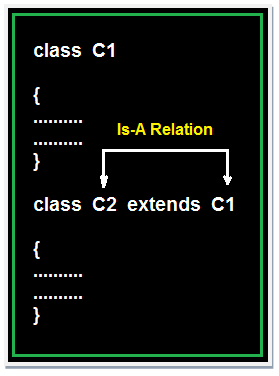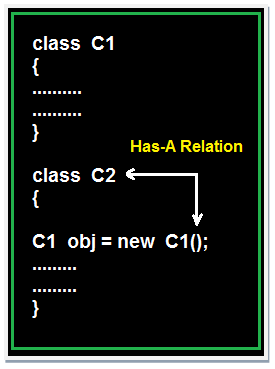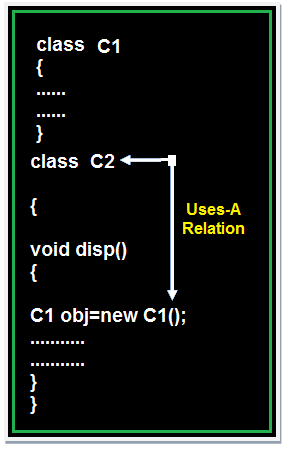Contents
Relationship in Java
Type of relationship always makes to understand how to reuse the feature from one class to another class. In java programming we have three types of relationship they are.
- Is-A Relationship
- Has-A Relationship
- Uses-A Relationship
Is-A relationship
In Is-A relationship one class is obtaining the features of another class by using inheritance concept with extends keywords.
In a IS-A relationship there exists logical memory space.

Example of Is-A Relation
Example
package com.andrewProgramming;
class Faculty {
float salary = 30000;
}
class Science extends Faculty {
float bonous = 2000;
public static void main(String args[]) {
Science obj = new Science();
System.out.println("Salary is:" + obj.salary);
System.out.println("Bonous is:" + obj.bonous);
}
}
Output
Salary is: 30000.0
Bonous is: 2000.0
Has-A relationship
In Has-A relationship an object of one class is created as data member in another class the relationship between these two classes is Has-A.
In Has-A relationship there existed physical memory space and it is also known as part of or kind of relationship.

Example of Has-A Relation
Example
package com.andrewProgramming;
class Employee {
float salary = 30000;
}
class Developer extends Employee {
float bonous = 2000;
public static void main(String args[]) {
Employee obj = new Employee();
System.out.println("Salary is:" + obj.salary);
}
}
Output
Salary is: 30000.0
Uses-A relationship
A method of one class is using an object of another class the relationship between these two classes is known as Uses-A relationship.

As long as the method is execution the object space (o1) exists and once the method execution is completed automatically object memory space will be destroyed.
Example of Uses-A Relation
Example
package com.andrewProgramming;
class Employee {
float salary = 30000;
}
class Salary extends Employee {
void disp() {
float bonous = 1000;
Employee obj = new Employee();
float Total = obj.salary + bonous;
System.out.println("Total Salary is:" + Total);
}
}
class Developer {
public static void main(String args[]) {
Salary s = new Salary();
s.disp();
}
}
Output
Total Salary is: 31000.0
Note 1: The default relationship in java is Is-A because for each and every class in java there exist an implicit predefined super class is java.lang.Object.
Note 2: The universal example for Has-A relationship is System.out (in System.out statement, out is an object of printStream class created as static data member in another system class and printStream class is known as Has-A relationship).
Note 3: Every execution logic method (main() ) of execution logic is making use of an object of business logic class and business logic class is known as Uses-A relationship.